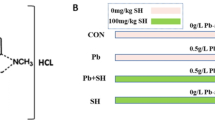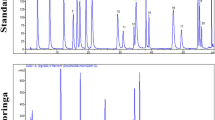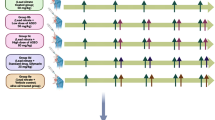Abstract
This study assessed prophylactic potentials of silymarin against lead-induced hepatorenal toxicity in rats with the respect to its antioxidant and anti-apoptotic activities. Forty male albino rats were distributed into four groups. Control group is provided with distilled water. Lead acetate group was given lead acetate (100 mg/kg bwt) orally for 10 weeks. The third and fourth groups administered silymarin at doses of 50 or 100 mg/kg bwt, respectively, 1 h before administration of lead acetate for 10 weeks. Lead acetate altered liver structure and function that represented by significant elevation of the activities of serum aspartate and alanine aminotransferases and serum levels of urea and creatinine. Hepatic and renal tissues’ malondialdehyde concentrations were increased, while reduced glutathione content and superoxide dismutase and catalase activities were reduced in the lead acetate group. Also, lead acetate increased caspase-3 mRNA expression and inhibited alpha-fetoprotein mRNA expression in hepatic tissues, as well as it altered liver and kidney tissues’ architectures. In contrast, silymarin ameliorated in a dose dependent mannar the toxic effects of lead acetate on the liver and kidneys through modulation of lead acetate which altered liver and kidney function and structures via reducing lipid oxidation and pathological changes of hepatic and renal tissue structure, improving antioxidant defense system of liver and kidneys, and decreasing pro-apoptotic gene expression in hepatic tissue. This study indicated that silymarin ameliorated lead acetate-induced hepatorenal toxicity via its antioxidant and cytoprotective potentials.
Graphical abstract




Similar content being viewed by others
Data availability
All data used in this study are included in this manuscript.
References
Abd Elrasoul ASA, Mousa AA, Orabi SH, Mohamed MAE, Gad-Allah SM, Almeer R, Abdel-Daim MM, Khalifa SAM, El-Seedi HR, Eldaim MAA (2020) Antioxidant, anti-inflammatory, and anti-apoptotic effects of Azolla pinnata ethanolic extract against lead-induced hepatotoxicity in rats. Antioxidants (Basel) 9(10):1014
Aebi H (1984) Catalase in vitro, Method. Enzymol. 105:121–126
Alhusaini AM, Faddah LM, Hasan IH, Jarallah SJ, Alghamdi SH, Alhadab NM, Badr A, Elorabi N, Zakaria E, Al-Anazi A (2019) Vitamin C and turmeric attenuate Bax and Bcl-2 proteins’ expressions and DNA damage in lead acetate-induced liver injury. Dose-Response 17:1559325819885782
Alkaladi A, Abdelazim AM (2013) Improved anti inflammatory effect of silymarin in rats induced liver carcinogenesis. World Appl Sci J 21(2):176–180
Al-Sayed E, Abdel-Daim MM (2014) Protective role of cupressuflavone from Cupressus macrocarpa against carbon tetrachloride-induced hepato- and nephrotoxicity in mice. Planta Med 80(18):1665–1671
Al-Sayed E, Martiskainen O, Seif el-Din SH, Sabra AN, Hammam OA, El-Lakkany NM, Abdel-Daim MM (2014) Hepatoprotective and antioxidant effect of Bauhinia hookeri extract against carbon tetrachloride-induced hepatotoxicity in mice and characterization of its bioactive compounds by HPLC-PDA-ESI-MS/MS. Biomed Res Int 2014:245171
Bancroft D, Stevens A, Turner R (1996) Theory and practice of histological techniques, 4th edn. Churchill Livingstone, Edinburgh, London, Melbourne
Basiglio CL, Sanchez Pozzi EJ, Mottino AD, Roma MG (2009) Differential effects of silymarin and its active component silybinin on plasma membrane stability and hepatocellular lysis. Chem Biol Interact 179:297–303
Beutler E, Duron O, Kelly BM (1963) Improved method for the determination of blood glutathione. J Lab Clin Med 61:882–888
Campbell JR, Moss ME, Raubertas RF (2000) The association between caries and childhood lead exposure. Environ Health Perspect 108(6):1099–1102
Ceribasi IH, Yetis U (2001) Biosorption of Ni (ii) and Pb (ii) by Phanaerochaete chrysosporium from a binary metal systemkinetics. Water SA 24:1–15
Das SK, Vasudevan DM (2006) Protective effects of silymarin, a milk thistle (Silybium marianum) derivative on ethanol-induced oxidative stress in liver. Indian J Biochem Biophys 43:306–311
Detaille D, Sanchez C, Sanz N, Lopez-Novoa JM, Leverve X, el-Mir MY (2008) Interrelation between the inhibition of glycolytic flux by silibinin and the lowering of mitochondrial ROS production in perifused rat hepatocytes. Life Sci 82:1070–1076
Dixit N, Baboota S, Kohli K, Ahmad S, Ali J (2007) Silymarin: a review of pharmacological aspects and bioavailability enhancement approaches. Indian J Pharm 39:172–179
Dribbena WH, Catherine E, Creeley B, Nuri F (2011) Low-level lead exposure triggers neuronal apoptosis in the developing mouse brain. Neurotoxicol Teratol 33(4):473–480
Duran EM, Shapshak P, Worley J et al (2005) Presenilin-1 detection in brain neurons and FOXp3 in peripheral blood mononuclear cells: normalizer gene selection for real time reverse transcriptase PCR using the ΔΔCt method. Front Biosci 10:2955–2965
El-Shitany NA, El-Haggar S, El-Desoky K (2008) Silymarin prevents adriamycin-induced cardiotoxicity and nephrotoxicity in rats. Food Chem Toicol 46:2422–2428
Fahmy NM, Al-Sayed E, Abdel-Daim MM, Karonen M, Singab AN (2016) Protective effect of Terminalia muelleri against carbon tetrachloride-induced hepato and nephro-toxicity in mice and characterization of its bioactive constituents. Pharm Biol 54(2):303–313
Fawcett JK, Scott JE (1960) A rapid and precise method for the determination of urea. J Chim Pathol 13:156–159
Ferreyra H, Romano M, Uhart M (2009) Recent and chronic exposure of wild ducks to lead in human-modified wetlands in Santa Fe Province, Argentina. J Wildl Dis 45:823–827
Flora SJS, Flora G, Saxena G (2006) Environmental occurrence, health effects and management of lead poisoning. In: Casas JS, Sordo J (eds) Lead: chemistry, analytical aspects, environmental impact and health effects. Elsevier Science, Amsterdam, pp 158–228
Flora SJS, Saxena G, Mehta A (2007a) Reversal of lead-induced neuronal apoptosis by chelation treatment in rats: role of reactive oxygen species and intracellular Ca2+. J Pharmacol Exp Ther 322:108–116
Flora SJS, Flora G, Saxena G, Mishra M (2007b) Arsenic and lead induced free radical generation and their reversibility following chelation. Cell Mol Biol (Noisy-le-grand) 53:26–47
GaZák R, Walterová D, Kren V (2007) Silybin and silymarin – new and emerging applications in medicine. Curr Med Chem 14:315–338
Gillessen A, Schmidt HH (2020) Silymarin as supportive treatment in liver diseases: a narrative review. Adv Ther 37(4):1279–1301
Henry RJ (1974) Creatinine measurements with colorimetric method, clinical chemical principles and techniques, 2nd edn. Harper and Row Publishers, New York, p 525
Holt GA, Chandra A (2002) Herbs in the modern healthcare environment an overview of uses, legalities and the role of the healthcare professional. Clin Res Regulatory Affairs (USA) 19:83–107
Hu KQ, Kyulo NL, Lim N, Elhazin B, Hillebrand DJ, Bock T (2004) Clinical significance of elevated alpha-fetoprotein (AFP) in patients with chronic hepatitis C, but not hepatocellular carcinoma. Am J Gastroenterol 99(5):860–865
Huang CH, Chang YY, Liu CW, Kang WY, Lin Y, Chang HC, Chen YC (2010) Fruiting body of Niuchangchih (Antrodia camphorata) protects livers against chronic alcohol consumption damage. J Agric Food Chem 58:3859–3866
Jia JD, Bauer M, Cho JJ, Rueh M, Milani S, Boigk G, Riecken EO, Schuppan D (2001) Antifibrotic effect of silymarin in rat secondary biliary fibrosis is mediated by downregulation of procollagen α1(I) and TIMP-1. J Hepatol 35:392–398
Karimi G, Ramezani M, Tahoonian Z (2005) Cisplatin nephrotoxicity and protection by milk thistle extract in rats. Evid Based Complement Alternat Med 2:383–386
Kaur G, Athar M, Alam MS (2010) Dietary supplementation of silymarin protects against chemically induced nephrotoxicity, inflammation and renal tumor promotion response. Investig New Drugs 28:703–713
Kim S, Choi MG, Lee HS, Lee SK, Kim SH, Kim WW, Hur SM, Kim JH, Choe JH, Nam SJ, Yang JH, Kim S, Lee JE, Kim JS (2009) Silibinin suppresses TNF-alpha-induced MMP- expression in gastric cancer cells through inhibition of the MAPK pathway. Molecules 14:4300–4311
Kosnett MJ (2006) Lead. In: Olson KR (ed) Poisoning and drug overdose, 5th edn. McGraw-Hill Professional, New York, pp 550–564
Lee DYW, Liu Y (2003) Molecular structure and stereochemistry of silybin A, silybin B, isosilybin A, and isosilybin B, isolated from Silybum marianum (Milk thistle). J Nat Prod 66:1171–1174
Ligeret H, Brault A, Vallerand D, Haddad Y, Haddad PS (2008) Antioxidant and mitochondrial protective effects of silibinin in cold preservation-warm reperfusion liver injury. J Ethnopharmacol 115:507–514
Lightfoot TL, Yeager JM (2008) Pet bird toxicity and related environmental concerns. Vet Clin N Am Exot Anim Pract 11:229–259
Liu Z, Li D, Zhao W, Zheng X, Wang J et al (2011) A potent lead induces apoptosis in pancreatic cancer cells. PLoS One 7(6):e37841
Malhi H, Gores GJ, Lemasters JJ (2006) Apoptosis and necrosis in the liver: a tale of two deaths? Hepatology 43:31–44
Mannem P (2014) Protective effects of ginger extract against lead induced hepatotoxicity in male albino rats. J Environ Sci Toxicol Food Technol 8:2319–2399
Mayer KE, Mayer RP, Lee SS (2005) Silymarin treatment of viral hepatitis: a systematic review. J Viral Hepat 12:559–567
Mizejewski GJ, Antelman DE, Keenan JF, Preiss IL (1990) Effects of heavy metals on alpha-fetoprotein in maternal sera and amniotic fluid of pregnant mice. Toxicology 64(1):19–13
Nishikimi M, Rao NA, Yagi K (1972) The occurrence of superoxide anion in the reaction of reduced phenazine methosulfate and molecular oxygen. Biochem Biophys Res Commun 46:849–854
Ohkawa H, Ohishi N, Yagi K (1979) Assay for lipid peroxides in animal tissues by thiobarbituric acid reaction. Anal Biochem 95:351–358
Oyagbemi AA, Odetola AA (2010) Hepatoprotective effects of ethanolic extract of Cnidoscolus aconitifolius on paracetamol-induced hepatic damage in rats. Pak J Biol Sci 13:164–169
Radko L, Cybulski W (2007) Application of silymarin in human and animal medicine. J Pre-Clin Clin Res 1:022–026
Ramakrishnan G, Augustine TA, Jagan S, Vinondhkumar R, Devaki T (2007) Effect of silymarin on N-nitrosodiethylamine induced hepatocarcinogenesis in rats. Exp Oncol 29:39–44
Reitmann S, Frankel S (1957) A colorimetric method for the determination of serum glutamate oxaloacetate and glutamate pyruvate transaminase. Am J ClinPath 28:56–61
Saller R, Melzer J, Reichling J, Brignoli R, Meier R (2007) An updated systematic review of the pharmacology of silymarin. Forsch Komp Klas Nat 14:70–80
Shaker E, Mahmoud H, Mnaa S (2010) Silymarin, the antioxidant component and silybum marianum extracts prevent liver damage. Food Chem Toxicol 48:803–806
Sharma RK, Agarwal M (2005) Biological effects of heavy metals; an overview. J Environ Biol 26:301–313
Singh D, Singh R, Singh P, Gupta RS (2009) Effects of embelin on lipid peroxidation and free radical scavenging activity against liver damage in rats. Basic Clin Pharmacol Toxicol 105(4):243–248
Skerfving S, Bergdahl IA (2007) In: 3rd ed., Nordberg GF, Fowler BA, Norberg M, Friberg LT (eds) Handbook on the toxicology of metals. Academic Press, Amesterdam, pp 599–643
Stickel F, Schuppan D (2007) Herbal medicine in the treatment of liver diseases. Dig Liver Dis 39:293–304
Sujatha K, Srilatha CH, Anjaneyulu Y, Amaravathi P (2011) Lead acetate induced nephrotoxicity in wistar albino rats. A pathological, immunohistochemical and ultrasructural studies. Int J Pharm Bio Sci 11:459–469
Tong MJ, Blatt LM, Kao VW (2001) Surveillance for hepatocellular carcinoma in patients with chronic viral hepatitis in the United States of America. J Gastroenterol Hepatol 16(5):553–559
Waggas AM (2012) Grape seed extract (Vitisvinifera) alleviate neurotoxicity and hepatotoxicity induced by lead acetate in male albino rats. J Behav Brain Sci 2:176–184
White LD, Cory-Slechta DA, Gilbert ME, Tiany-Castiglioni E, Zawia NH, Virgolini M, Rossi-George A, Lasley SM, Qian YC, Basha MR (2007) New and evolving concepts in the neurotoxicology of lead. Toxicol Appl Pharmacol 225:1–27
Wu DF, Peng RX (2003) The effect of silymarin on hepatic microsomal and mitochondrial membrane fluidity in mice. Chin J Chin Meter Med 28:817–872
Yang HY, Lin KR (2006) The mechanism of silymarin to treat fatty hepatitis. J Chin Modern Med 3:876–878
Yeung AWK, Tzvetkov NT, El-Tawil OS, Bungǎu SG, Abdel-Daim MM, Atanasov AG (2019) Antioxidants: scientific literature landscape analysis. Oxidative Med Cell Longev 2019(8):8278454
Acknowledgements
The authors acknowledge the Taif University Researchers Supporting Project number (TURSP-2020/57), Taif University, P.O. Box 11099, Taif 21944, Saudi Arabia.
Funding
The current work was funded by Taif University Researchers Supporting Project number (TURSP - 2020/57), Taif university, Taif, Saudi Arabia.
Author information
Authors and Affiliations
Contributions
Abd Eldaim MA, Barakat ER, and Ahmed SA suggested the goal and the experimental design; Abd Eldaim MA, Barakat ER, and Alkafafy M performed the experiment with the help of Ahmed SA; Abd Eldaim MA and Ahmed SA supervised the implementation of the experiment; Abd Eldaim MA, Barakat ER, and Ahmed SA analyzed the results; Barakat ER and Alkafafy M conducted the histopathological examination. All authors discussed the results, write the draft of the manuscript, and finalize the manuscript.
Corresponding author
Ethics declarations
Ethical approval
This study was approved by the International Animal Care and Use Committee, Faculty of Veterinary Medicine, University of Sadat City, Egypt with approval number, Vusc-005-5-20, which follows the Guide for the Care and Use of Laboratory Animals 8th edition Washington (DC): National Academies Press (US); 2011.
Informed consent
Not applicable as our study did not involve humans.
Conflict of interest
The authors declare no competing of interests.
Additional information
Responsible Editor: Mohamed M. Abdel-Daim
Publisher’s note
Springer Nature remains neutral with regard to jurisdictional claims in published maps and institutional affiliations.
Rights and permissions
About this article
Cite this article
Abd Eldaim, M.A., Barakat, E.R., Alkafafy, M. et al. Antioxidant and anti-apoptotic prophylactic effect of silymarin against lead-induced hepatorenal toxicity in rats. Environ Sci Pollut Res 28, 57997–58006 (2021). https://doi.org/10.1007/s11356-021-14722-8
Received:
Accepted:
Published:
Issue Date:
DOI: https://doi.org/10.1007/s11356-021-14722-8




